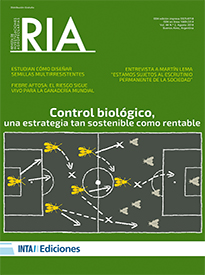Ver ítem
- xmlui.general.dspace_homeCentros Regionales y EEAsCentro Regional Entre RíosEEA ConcordiaArtículos científicosxmlui.ArtifactBrowser.ItemViewer.trail
- Inicio
- Centros Regionales y EEAs
- Centro Regional Entre Ríos
- EEA Concordia
- Artículos científicos
- Ver ítem
Caracterización de aislamientos de moho verde (Penicillium digitatum) resistentes al fungicida pirimetanil en la región citrícola del río Uruguay
Resumen
El uso continuado de los fungicidas tiabendazol e imazalil en los empaques citrícolas de la región del río Uruguay ha llevado a la selección y proliferación de aislamientos de moho verde resistentes; este hongo es la principal causa de podredumbres en poscosecha. Recientemente, el fungicida pirimetanil (anilino-pirimidina) (PYR) se ha incorporado a los programas de control de esta enfermedad. El objetivo del presente trabajo fue estudiar la resistencia a
[ver mas...]
El uso continuado de los fungicidas tiabendazol e imazalil en los empaques citrícolas de la región del río Uruguay ha llevado a la selección y proliferación de aislamientos de moho verde resistentes; este hongo es la principal causa de podredumbres en poscosecha. Recientemente, el fungicida pirimetanil (anilino-pirimidina) (PYR) se ha incorporado a los programas de control de esta enfermedad. El objetivo del presente trabajo fue estudiar la resistencia a este fungicida de una colección de aislamientos, obtenida luego de que este principio activo se incorporara a los programas de control en los empaques citrícolas durante un período de aproximadamente 5 años. 122 aislamientos de moho verde fueron recolectados desde Monte Caseros (Corrientes) hasta Concordia (Entre Ríos) durante 2015. Estos fueron obtenidos de frutos con síntomas del patógeno en campo y empaque. Se determinó la concentración de PYR que reduce el crecimiento de las colonias en un 50% (EC50) para cada aislamiento. La EC50 media de los aislamientos recolectados en campo fue de 0,16 ± 0,02 μg mL-1. No se observaron aislamientos resistentes en campo donde el fungicida no es usado. Por el contrario, el 64,4% de los aislamientos recolectados en empaques se muestran resistentes a PYR, con una EC50 media de 5,51 ± 0,37 μg mL-1. Los sensibles presentan una EC50 media de 0,20 ± 0,02 μg mL-1. La información suministrada en este trabajo resulta importante en el monitoreo de la susceptibilidad del moho verde al fungicida PYR en la región citrícola del río Uruguay. La incorporación de este fungicida en los programas de control de moho verde debe hacerse en forma cuidadosa, implementando distintas estrategias para lograr resultados efectivos.
[Cerrar]
The continuous use of the fungicides thiabendazol and imazalil in the citrus packing houses of the Uruguay River region has led to the selection and proliferation of resistant green mold isolates, being this fungus the main cause of postharvest rot. Recently, the fungicide pyrimethanil (anilino-pyrimidine) (PYR) has been incorporated into the control programs of this disease. The objective of the present work was to study the resistance to this fungicide
[ver mas...]
The continuous use of the fungicides thiabendazol and imazalil in the citrus packing houses of the Uruguay River region has led to the selection and proliferation of resistant green mold isolates, being this fungus the main cause of postharvest rot. Recently, the fungicide pyrimethanil (anilino-pyrimidine) (PYR) has been incorporated into the control programs of this disease. The objective of the present work was to study the resistance to this fungicide of a collection of isolates, obtained after this active principle was incorporated into control programs in the citrus packaging houses during a period of approximately 5 years. 122 green mold isolates were collected from Monte Caseros (Corrientes) to Concordia (Entre Ríos) during 2015. They were obtained from fruits with symptoms of the pathogen in the field and packaging. The concentration of PYR which reduces colony growth by 50% (EC50) was determined for each isolation. The mean EC50 of the field-collected isolates was 0.16 ± 0.02 μg mL-1. No resistant isolates were observed in the field where the fungicide is not used. In contrast, 64.4% of those collected from packing houses were resistant to PYR, with an average EC50 5.51 ± 0.37 μg mL-1. Those sensible isolates showed an EC50 mean 0.20 ± 0.02 μg mL-1. The information provided in this work is important for monitoring susceptibility of green mold to the fungicide PYR in the citrus region of the Uruguay River. The incorporation of this fungicide in green mold control programs must be done carefully, and different strategies must be implemented to achieve effective results.
[Cerrar]

Fuente
RIA 44 (2) : 61-64 (agosto 2018)
Fecha
2018-08
ISSN
0325-8718
1669-2314
1669-2314
Formato
pdf
Tipo de documento
artículo
Palabras Claves
Derechos de acceso
Abierto
 Excepto donde se diga explicitamente, este item se publica bajo la siguiente descripción: Creative Commons Attribution-NonCommercial-ShareAlike 2.5 Unported (CC BY-NC-SA 2.5)
Excepto donde se diga explicitamente, este item se publica bajo la siguiente descripción: Creative Commons Attribution-NonCommercial-ShareAlike 2.5 Unported (CC BY-NC-SA 2.5)


